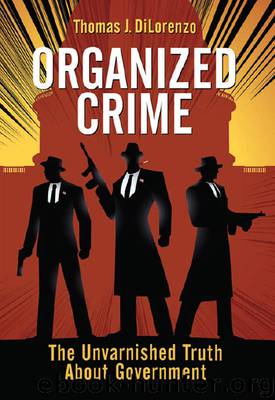Organized Crime by Thomas J. DiLorenzo

Author:Thomas J. DiLorenzo [DiLorenzo, J. Thomas]
Language: eng
Format: epub
ISBN: 978-1-61016-560-0
Publisher: Ludwig von Mises Institute
Published: 2012-03-24T16:00:00+00:00
SECTION4
Money and the State
CHAPTER30
Central Banking as an Engine of Corruption
Much has been written about the famous debate between Thomas Jefferson and Alexander Hamilton over the constitutionality of America’s first central bank, the Bank of the United States (BUS). This was where Jefferson, as secretary of state, enunciated his “strict constructionist” view of the Constitution, making his case to President George Washington that since a national bank was not one of the powers specifically delegated by the states to the central government, and since the idea was explicitly rejected by the constitutional convention, a central bank is unconstitutional. Treasury Secretary Hamilton notoriously responded by inventing the notion of “implied” as opposed to explicit, delegated powers in the Constitution.
George Washington signed legislation creating the BUS not because of the strength of Hamilton’s argument but because of a shady political deal. The nation’s capital was being relocated from New York to Virginia, and Washington wanted the border of the new District of Columbia to abut his property at Mount Vernon. In return for redrawing the district’s border (presumably enhancing his property value), Washington signed the Federalists’ legislation creating the BUS.
America’s first central bank was borne of a corrupt political deal, but that particular act of political chicanery pales in comparison to what Hamilton and his fellow nationalists really had in mind for the country. As Murray Rothbard wrote in The Mystery of Banking, Hamilton and his political compatriots, especially the politically-connected defense contractor Robert Morris, wanted
to reimpose in the new United States a system of mercantilism and big government similar to that in Great Britain, against which the colonists had rebelled. The object was to have a strong central government, particularly a strong president or king as chief executive, built up by high taxes and heavy public debt.
An especially important part of what Rothbard called “the Morris scheme” was “to organize and head a central bank, to provide cheap credit and expanded money for himself and his allies.”
Hamilton was essentially Robert Morris’s plant in the Washington administration whose assignment was to create a British-style “mercantilist” economic system that would primarily benefit plutocrats like Morris at the expense of nearly everyone else. As explained by historian Douglas Adair, an editor of The Federalist Papers:
[W]ith devious brilliance, Hamilton set out, by a program of class legislation, to unite the propertied interests of the eastern seaboard into a cohesive administration party, while at the same time he attempted to make the executive dominant over the Congress by a lavish use of the spoils system. In carrying out his scheme . . . Hamilton transformed every financial transaction of the Treasury Department into an orgy of speculation and graft in which selected senators, congressmen, and certain of their richer constituents throughout the nation participated.
What Professor Adair is talking about here is how Hamilton went about nationalizing the old government debt. New government bonds were issued and the old debt was to be cashed out at face value. This plan immediately became public knowledge in New York City
Download
This site does not store any files on its server. We only index and link to content provided by other sites. Please contact the content providers to delete copyright contents if any and email us, we'll remove relevant links or contents immediately.
| Elections & Political Process | Ideologies & Doctrines |
| International & World Politics | Political Science |
| Public Affairs & Policy | Specific Topics |
| United States |
The Secret History by Donna Tartt(18851)
The Social Justice Warrior Handbook by Lisa De Pasquale(12143)
Thirteen Reasons Why by Jay Asher(8797)
This Is How You Lose Her by Junot Diaz(6796)
Weapons of Math Destruction by Cathy O'Neil(6147)
Zero to One by Peter Thiel(5689)
Beartown by Fredrik Backman(5600)
The Myth of the Strong Leader by Archie Brown(5427)
The Fire Next Time by James Baldwin(5250)
How Democracies Die by Steven Levitsky & Daniel Ziblatt(5129)
Promise Me, Dad by Joe Biden(5088)
Stone's Rules by Roger Stone(5027)
A Higher Loyalty: Truth, Lies, and Leadership by James Comey(4846)
100 Deadly Skills by Clint Emerson(4840)
Rise and Kill First by Ronen Bergman(4705)
Secrecy World by Jake Bernstein(4647)
The David Icke Guide to the Global Conspiracy (and how to end it) by David Icke(4628)
The Farm by Tom Rob Smith(4439)
The Doomsday Machine by Daniel Ellsberg(4417)
